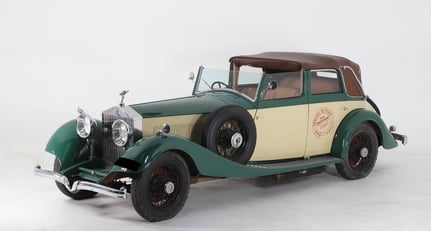1934 Rolls-Royce Phantom II
Continental Convertible 3-Positions Fernandez & Darrin-
Year of manufacture1934
-
Car typeOther
-
Chassis number99RY
-
Engine numberSU15
-
Lot number49
-
DriveRHD
-
ConditionRestored
-
Interior colourBrown
-
Number of doors2
-
Location

-
Exterior colourOther
-
Drivetrain2wd
-
Fuel typePetrol
Description
Dutch registration title
Rediscovery of this very rare Fernandez & Darrin bodywork wrongly attributed to Kellner for so many years.
Very nice presentation and perfect working condition
Clear factory data sheet and history
In 1906, at the Olympia Hall Motor Show in London, Henry Royce, a self-taught genius mechanic, and Charles Rolls, an aristocratic engineer with a passion for mechanics, presented the most famous of all their creations, the 40/50 HP, now known as the Silver Ghost, in reference to the car chassis number #AX201 painted in silver grey. It was the first of the "big" Rolls-Royces. Manufactured in 7,874 units, it was to establish the reputation of the venerable English firm throughout the world, at a time when the British Empire dominated the world. Its 6-cylinder engine (with a capacity of 7 litres, then 7.4 litres from 1910) offered a level of technical reliability never before seen in a car. Its replacement, the New Phantom, appeared in 1925 and was manufactured in England, but also in the United States, where it competed with the most prestigious American cars of the time. Its new 6-cylinder, 7.7-litre engine was incredibly quiet, thanks to an innovative distribution system that generated no vibrations. It was produced in 2,269 units in England until 1929, and 1,243 units in the USA until 1931. Its replacement, the Phantom II (the New Phantom was retroactively named Phantom I), was launched in 1929. It had the same 7.7-litre 6-cylinder engine as its big sister, but had a stiffer chassis and better running gear. In 1931, on the basis of this Phantom II, Henry Royce had a short-chassis version built, called Continental, for the more sporty drivers who wanted to take the wheel themselves... Almost shocking, since until then Rolls-Royce had long chassis and separate driving positions for salaried drivers. With an engine that had a prepared cylinder head and a higher compression ratio, the Continental allowed its driver to flirt with 170 km/h, a barely believable speed for such an imposing car. In the early 1930s, it was the best car in the world, also thanks to its adjustable suspension, synchronised gearbox and power braking. Of the 1,767 Phantom IIs, only 281 were Continental. In 1935, the Phantom III, now equipped with a V12 engine, closed the beautiful history of the luxurious and inimitable "big" Rolls-Royce 6-cylinder cars.
This Phantom II is therefore one of the very few short-chassis Continentals. It was ordered new by Juliette and Jacques Violet, a very prominent couple in Paris during the Roaring Twenties. He was the heir to the Byrhh aperitifs, a drink which, in the mid-1930s, occupied more than 50% of the aperitif market! She was the granddaughter of Edmond Bartissol, an engineer who took part in the digging of the Suez Canal, then a member of parliament for the Pyrénées-Orientales (Jacques Violet's home region) and creator of… an aperitif that bears his name. Juliette and Jacques Violet, who divide their time between a sumptuous mansion on the very chic Avenue Foch and the Villa Palauda in Thuir (in fact, a palace), have a bit of a folie de grandeur. They received the Tout-Paris at their table, were among the best clients of the very select jeweller Van Cleef & Arpels and went to Maxim's with two Rolls-Royces, for example, in case one of them broke down, according to the legend... The records of the British factory indicate that in 1932 they placed an order for two Phantom IIs, which were sent to Fernandez & Darrin to be bodied as a Coupe de Ville. And the Phantom II which illustrates these pages, previously considered - wrongly! - as a Kellner cabriolet, is in fact the third Phantom II of the Violet couple bodied by Fernandez & Darrin. The factory records are very clear on this point, as they indicate that chassis #99RY was ordered by "Mr" J. Violet (24 January 1934), via FBA Ltd (in fact the French importer Franco-Britannic Autos Limited), and delivered to "Fernandez" on 19 April 1934, after crossing the Channel on the "SS Volga" (steam ship). The car, bodied as an "inside drive 4-doors completely collaspsible" (in fact a sort of 3-position convertible), was not tested by FBA Ltd until 21 March 1935, and the delay in completing the bodywork at Fernandez could explain the impatience of the Violet family, who seem to have resold #99RY, exported to England that year, and registered BYM 374. In the 1950s, it was in the hands of a US Army Lieutenant-Colonel, and then of a certain David Dangler, living in Illinois. In the 2000s, it was the Dutch businessman and well-known collector Anton aan de Stegge who acquired it and prepared it to take part in the very difficult Peking-Paris race. It did not take part in the event, but was entered in the 2005 Borneo Experience Tour, a 1,200 km ride through Malaysia and the Sultanate of Brunei. It was bought by Mr Gratzmüller in 2014, and has been little used since. However, our test drive of it was bluffing, as the car is so smooth and pleasant. Some improvements, such as an electric power steering or more modern front seats, contribute greatly to the pleasure of driving this Phantom II Continental, a witness of a past sumptuous era.
This car will be sold by auction by AGUTTES Auction House, in Neuilly-sur-Seine, France, on June the 20th, 2021.
The digital catalog is available by the following link
https://www.aguttes.com/en/catalog/113642?
Please contact us for any further details.
[email protected]
+33 147 459 301
+ 33 668 362 622







